This article is more than 1 year old
Weekend reads: Consumed, The Graphic Art of the Underground and The Skeleton Road
David Cronenberg tries his hand at novel writing
The Graphic Art of the Underground
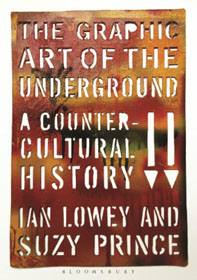
The authors of this book were the co-editors of the UK alternative arts mag: Nude which ran until 2011. Suzy Prince was also the curator of the Last Chance Saloon gallery in London. So clear some space on the coffee table and prepare yourself for a visual feast.
The Graphic Art of the Underground is divided into five chapters which outline the development of the genre in the last sixty years. It begins by discussing the hot rod and kustom kar movement on the West Coast during the 1950s and 1960s and shows how the work of artists such as Ed "Big Daddy" Roth who would go on to influence the psychedelic movement and the underground comic scene.
George Melly is quoted: “The underground is the first of the pop explosions to have evolved a specifically graphic means of expression ... which would provide a parallel to its musical, literary and psychological aspects.”
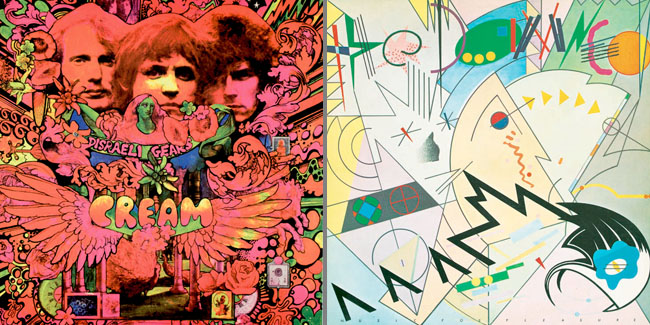
What a difference a decade makes: Martin Sharp (left) Disraeli Gears by Cream (1967)
Barney Bubbles (right) Music for Pleasure by The Damned (1976)
Naturally, there are numerous examples of London and West Coast psychedelic graphics in the book. However, either time has dated them or I obviously haven’t taken enough drugs lately, as they appear rather hackneyed and dull and the individual artists somewhat generic. There are a few glaring graphic omissions, Gilbert Shelton’s name is mentioned, but the artwork for his Fabulous Furry Freak Brothers is nowhere to be found, favouring Robert Crumb and in some cases less iconic works of obscure artists.
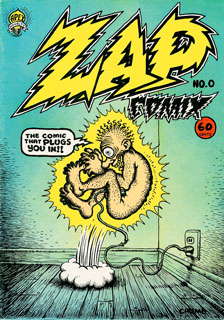
Zap comic illustrated by Robert Crumb (1970)
We move on to the rebellion of the punk movement, featuring Jamie Reid’s impressive Sex Pistols artwork. It is noticeable that given this is a graphic-oriented book there are numerous examples of brilliant packaging disguising less than impressive contents, for instance Barney Bubbles’ great design for the second forgettable album by The Damned, Music for Pleasure.
Peter Saville’s Russian Constructivist design for the first lacklustre New Order album is shown, rather than his less derivative, yet equally impressive design for Joy Division’s far superior debut LP Unknown Pleasures.
There are however a few surprises: The photographic and collage work of Linder Sterling is excellent and it is revealed that Winston Smith of Dead Kennedys fame (featured in an earlier Page File here) studied fine art in Florence.
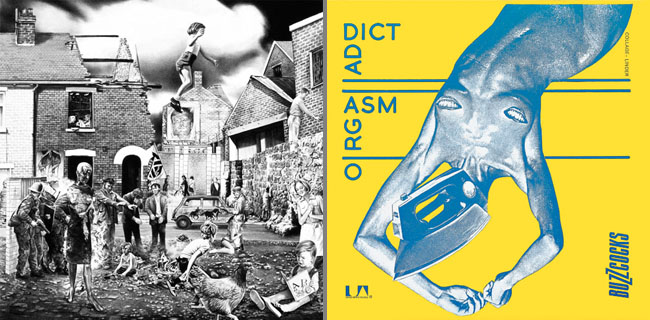
Cut, copy and paste: Gee Vaucher (left) Feeding of the 5000 by Crass
Linder Sterling collage/Malcolm Garrett design (right) for Orgasm Addict by Buzzcocks
Despite concentrating almost entirely on the UK and California, the first three sections of the book are fairly well presented and discussed. There are omissions and some of the obvious influences are mentioned a little late in the day or not at all, but that is to be expected in a 270-page book covering such a vast subject.
The last two sections are somewhat disappointing, the first concerns lowbrow art and pop surrealism, the second designer toys and indie crafting. Firstly, there is no youth or any other kind of movement to go with them. To go back to Melly, no parallel musical, literary or psychological aspects whatsoever.
Still, there is the occasional ironic album cover, much of the content is derivative and while well executed, it is to borrow a phrase from a previous underground culture: pretty vacant, not so much lowbrow as wilfully thick. There are too many bug eyed offspring of Disney and Manga – the toys are just toys.
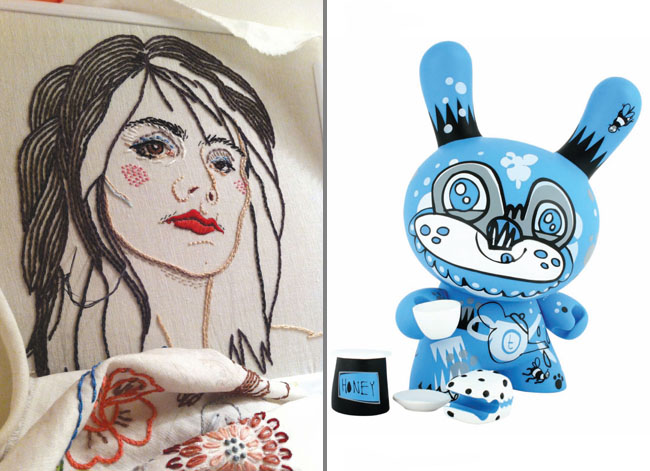
Art for art's sake: Jenny Hart (left), Sublime Stitching – PJ Harvey
Jon Burgerman (right) – 3 Bears Dunny, produced by Kidrobot
There are a few well crafted embroideries of rock icons, such as Iggy Pop and PJ Harvey, but behind the surface, there seems to be a dearth of original ideas. I get the impression that most of the artists included here have been featured in Nude magazine, shown at the Last Chance Saloon or are on the syllabus of the author’s Introduction To Contemporary Visual Arts teaching programme.
In short, a lot of the work here gives the impression of being self serving and self referential. To judge by this book it would seem the underground expired in the 1980s and what remains is only the authors’ retrospective. The final two chapters seem to consist of a few art students who have jumped on a bandwagon which the wheels fell off long ago.
I can recommend The Graphic Art of the Underground to any young graphics or design student without much sense of history. That said, anyone wishing to investigate the subject more deeply – and elder statespersons of the underground – will have to accept that there’s only so much you can say in a book of this size and they may need to seek out supplementary tomes to add some graphic detail.
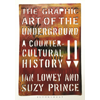 Author Ian Lowey and Suzy Prince
Author Ian Lowey and Suzy Prince
Title The Graphic Art of the Underground – A Countercultural History
Publisher Bloomsbury
Price £29.99 (Hardback), £29.99 (EPUB eBook)
More info Publication web site
